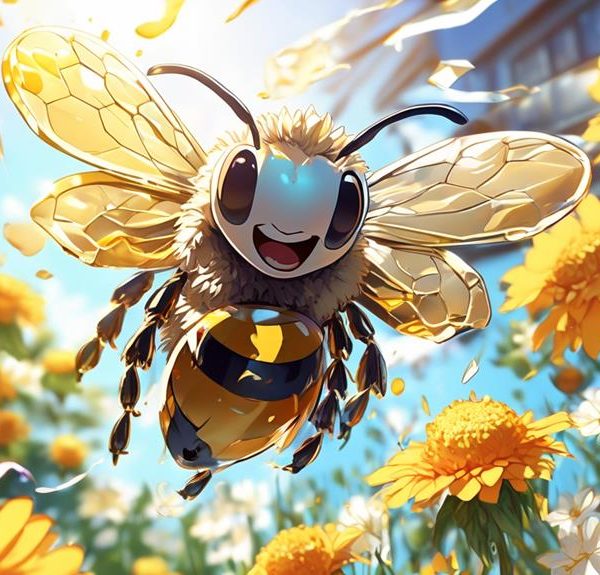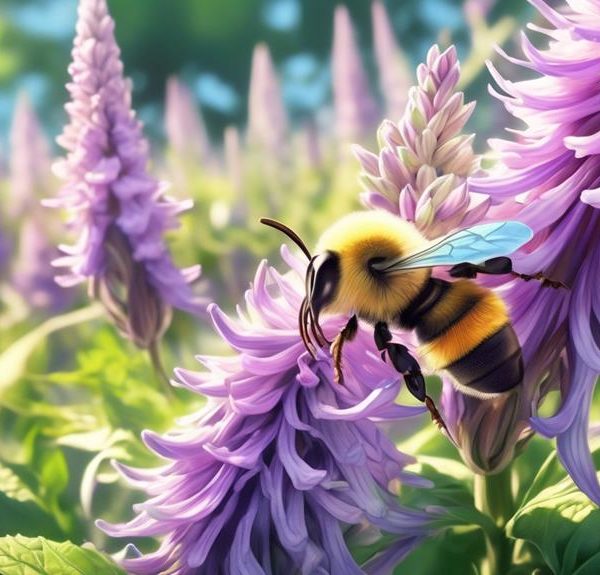Learn about the intriguing relationship between bees and the amaranth plant, an insight that could transform your gardening practices.
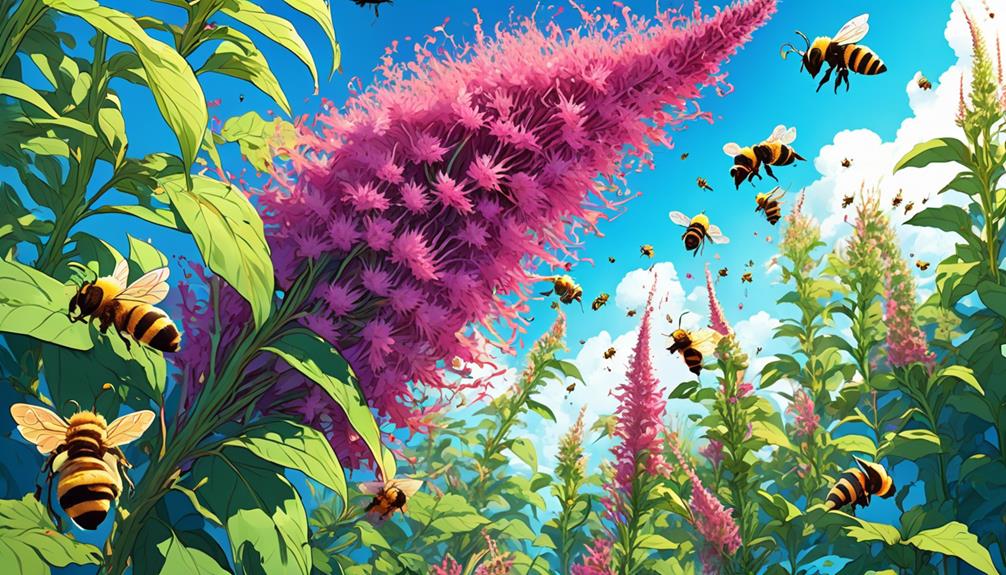
Do Bees Like Amaranth
Have you ever pondered the relationship between bees and the exotic amaranth plant? You're not alone. In the vast world of botany and entomology, the connections between specific plants and insects create a fascinating web of interdependence.
Bees, with their crucial role in pollination, have preferences, and it's intriguing to explore what those might be. Dive into the intriguing complexity of our ecosystem, where the question arises: do bees have a fondness for the amaranth plant?
This topic may seem obscure, but its understanding can shed light on broader ecological dynamics and potentially guide our gardening choices towards more sustainable practices.
Key Takeaways
- Amaranth is highly beneficial for bees as it provides a rich source of nectar and pollen, contributing to their survival and ecosystem health.
- Bees play a crucial role in pollination, and without them, plant reproduction would be challenging, leading to a decrease in biodiversity.
- Bees are attracted to bright, vivid colors and fragrant plants, especially those with a sweet scent, making amaranth an attractive option for them.
- Amaranth not only offers essential nutrition for bees but also ensures a reliable food source during late-season blooming when other flowers cease to bloom.
Understanding the Amaranth Plant
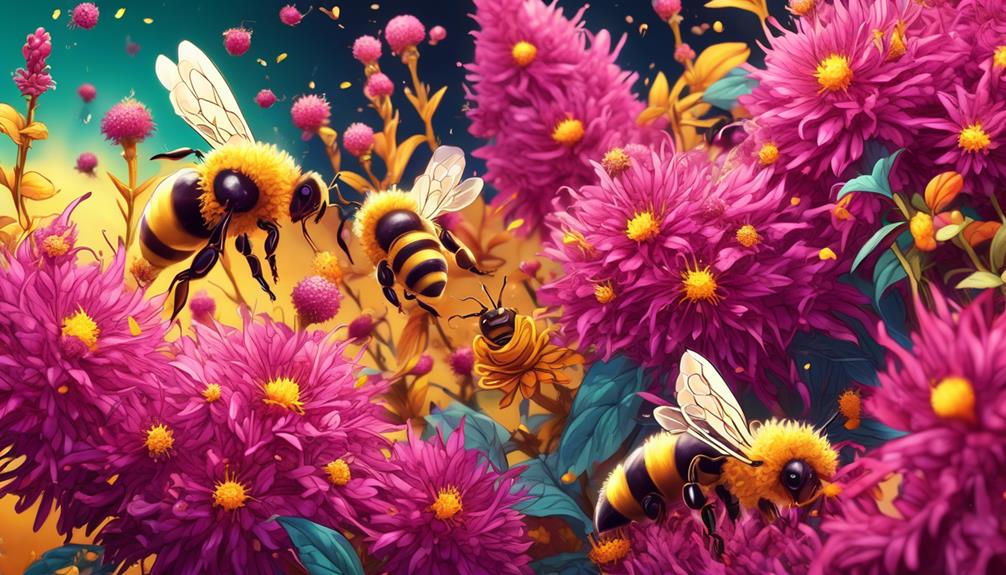
Diving into the world of botany, you'll find that the amaranth plant, a vibrant and versatile species, plays a pivotal role in numerous ecosystems around the globe. It's a genus of annual or short-lived perennial plants, some with colorful pseudoflowers. Amaranthus, the scientific name for amaranth, boasts about 60 to 70 species, showcasing a remarkable biodiversity.
The amaranth plant is highly adaptable, thriving in a variety of climates and soil types. It's known for its rapid growth and high biomass production, which offers significant ecological benefits, such as soil stabilization and carbon sequestration. It's also an excellent source of nectar and pollen for bees, contributing to their survival and the overall health of our planet's ecosystems.
Nutritionally, you'll find amaranth is a powerhouse. It's packed with proteins, vitamins, and minerals, which makes it a crucial food source for both humans and animals. It's even been identified as a potential solution to food security issues worldwide due to its resilience to drought and heat.
The Importance of Bees in Pollination
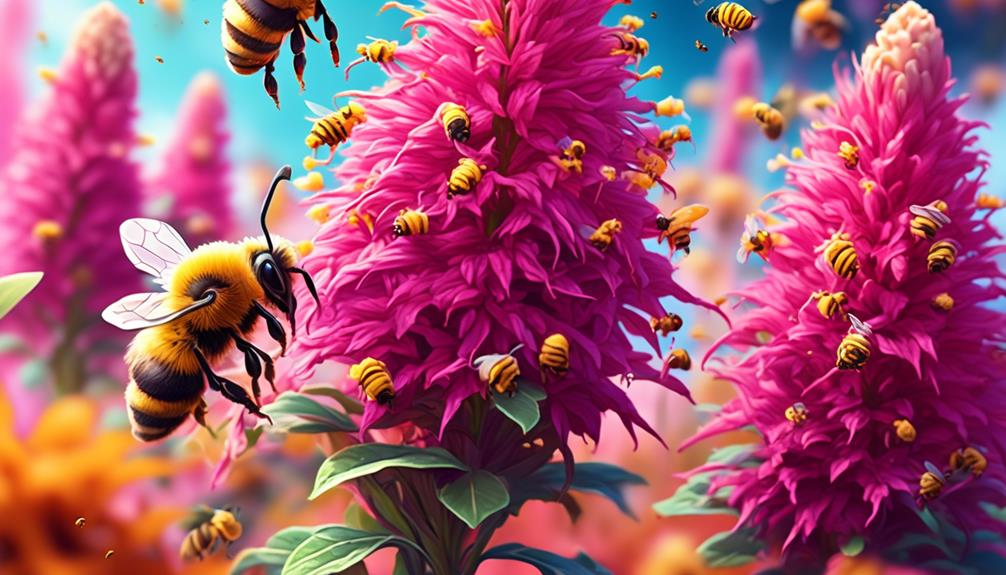
While the amaranth plant serves as a vital source of nutrients for bees, it's important to understand the significant role these buzzing insects play in the process of pollination. As a key player in this biological process, bees often transfer pollen from the male parts of a flower to the female parts, leading to fertilization and ultimately the production of seeds.
You mightn't realize it, but approximately 75% of the world's flowering plants depend on pollinators like bees. That includes a third of the food we eat! Without bees, many plants would struggle to reproduce and the biodiversity of our planet could dramatically decrease.
Moreover, bees aren't just crucial for nature's sake; they're also essential for our economy. The economic value of pollination services provided by bees in the United States alone is estimated to be between $10 billion and $15 billion annually.
Bees' Attraction to Different Plants
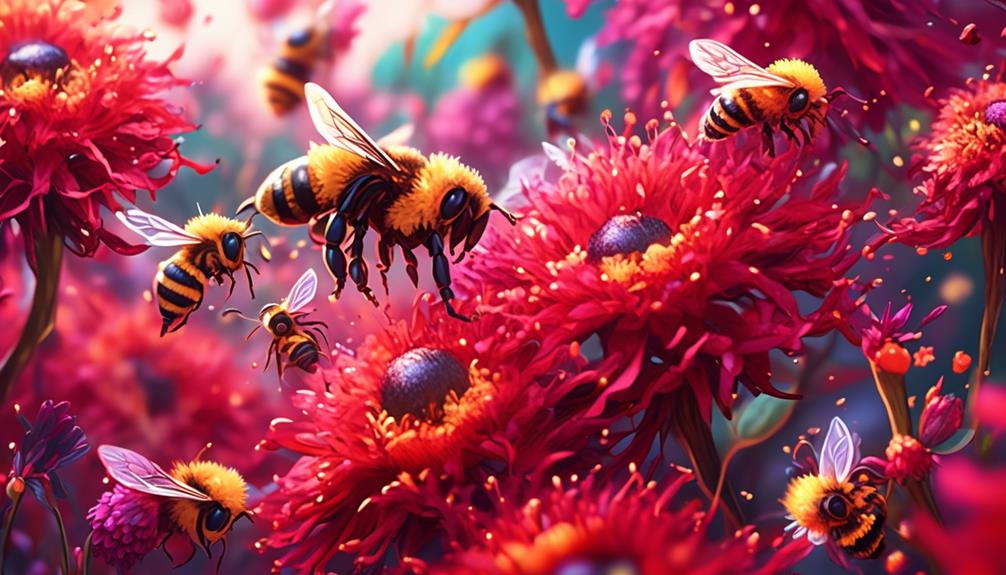
In your garden, you might've noticed that bees are particularly drawn to certain plants, exhibiting a unique affinity based on factors such as scent, color, and the availability of nectar and pollen. This isn't a random occurrence, but a calculated decision made by these industrious workers.
Bees, like many insects, are attracted to bright, vivid colors. They're especially fond of yellow, purple, and blue hues, which they perceive through their trichromatic vision. So, plants with these color blooms tend to attract more bees. In addition, they're drawn to fragrant plants, especially those that exude a sweet scent, as it indicates a rich nectar source.
The shape of a flower can also affect a bee's attraction. They prefer easy access, so open-faced flowers, like sunflowers or daisies, are more appealing. However, certain bee species have developed long tongues to extract nectar from tube-like flowers, like foxgloves.
Planting a variety of these bee-friendly flowers in your garden can help support local bee populations. Remember, the more diverse your garden is, the wider variety of bees you'll attract. It's a win-win situation for both you and the bees.
Amaranth and Bee Interactions
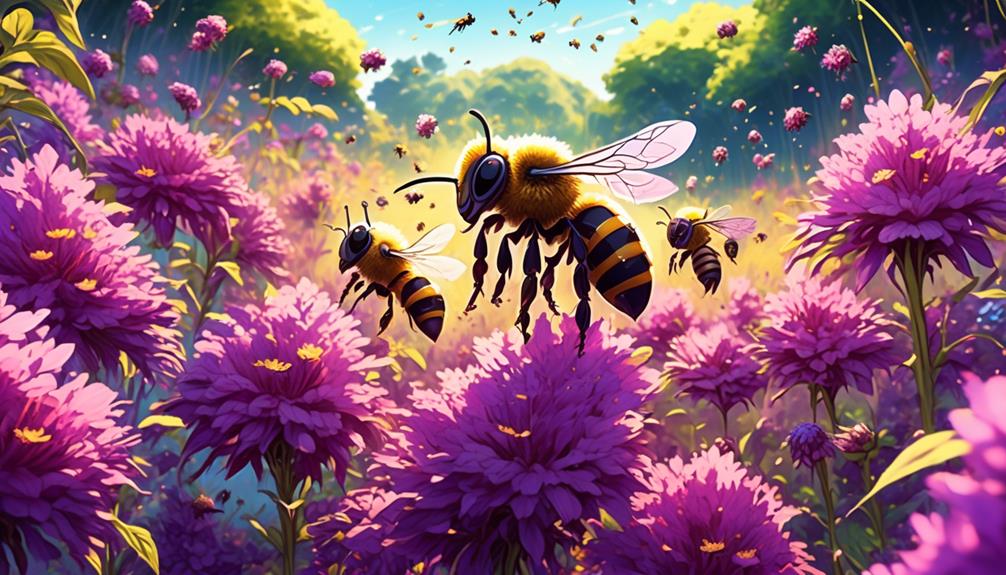
Turning our attention to the amaranth plant, you might wonder how this vibrant and fragrant species interacts with our buzzing friends, the bees. This relationship is intriguing, as the amaranth's bright colors and sweet scent are known to attract a variety of pollinators.
Bee Interaction | Amaranth Species | Effect on Pollination |
|---|---|---|
Honeybees | Red Amaranth | High pollination efficiency |
Bumblebees | Globe Amaranth | Moderate pollination efficiency |
Wild Bees | Prince-of-Wales Feather | Low pollination efficiency |
The first row in the table indicates that honeybees have a high efficiency in pollinating red amaranth plants. Bumblebees, on the other hand, show a moderate level of pollination efficiency with the Globe Amaranth. However, wild bees seem to have a lower efficiency when it comes to Prince-of-Wales Feather species.
The data in this table suggests that different bees interact differently with various amaranth species. It's important to note that these interactions can influence the health and growth of amaranth plants. Therefore, understanding these interactions can be crucial for cultivating a thriving amaranth garden.
Benefits of Amaranth for Bees
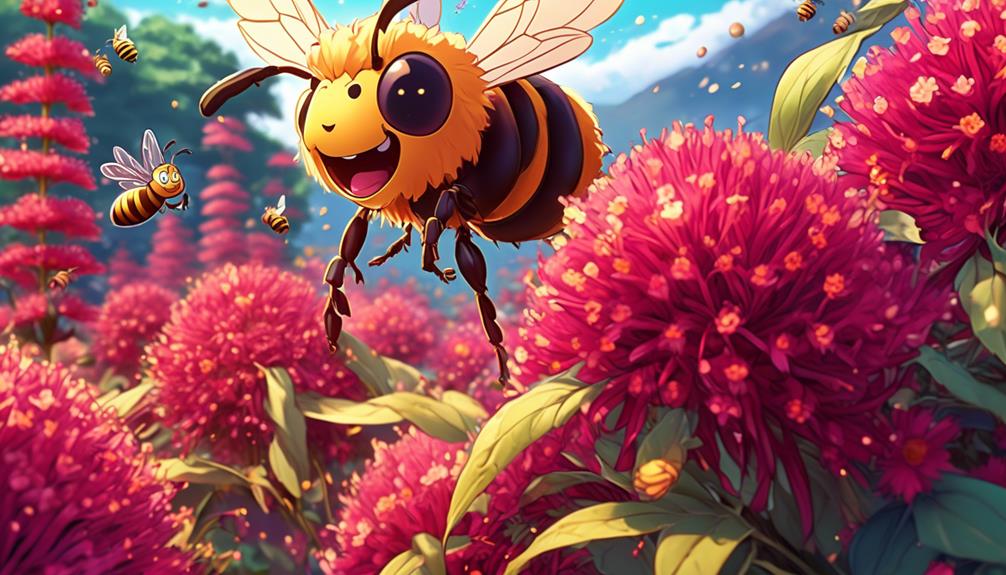
You might be surprised to learn that amaranth plants offer substantial benefits to bees, acting not only as a source of nutrition, but also playing a pivotal role in their survival and propagation.
The amaranth's nectar provides bees with essential carbohydrates, while its pollen serves as a protein source – both key components in bee nutrition. A bee's lifespan, reproductivity, and resistance to disease can improve significantly when they have access to amaranth.
Moreover, amaranth plants bloom late in the season, which is crucial for bees. As many flowers cease blooming by late summer, bees often struggle to find the nutrients they need. Amaranth, however, provides a reliable, late-season food source, aiding in the bees' survival into the following spring.
Furthermore, bees that feed on amaranth gain exposure to a diverse array of pollen and nectar sources, which can enhance their immune response and resilience against pathogens and pesticides. Thus, by incorporating amaranth into their diet, bees not only receive the sustenance they require, but also bolster their overall health and longevity.
It's clear that amaranth plays an indispensable role in supporting bee populations.
Creating a Bee-Friendly Garden With Amaranth
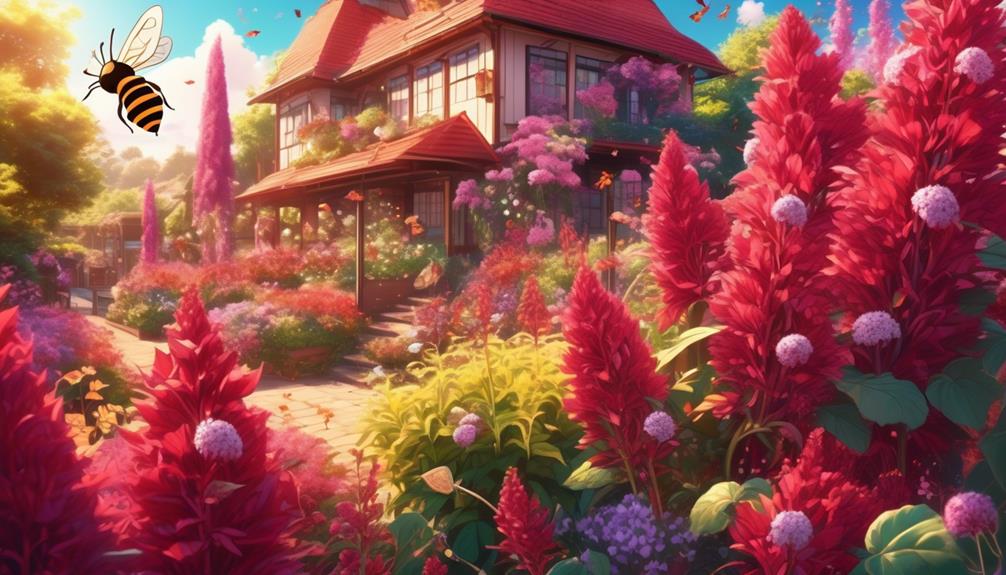
Cultivating a bee-friendly garden with amaranth isn't just beneficial for the bees; it can also add a vibrant splash of color to your landscape and ensure a healthy ecosystem in your backyard. This versatile plant, rich in essential nectar, acts as a powerful attractant for bees and other beneficial insects.
To create a thriving bee sanctuary, you must pay attention to the nitty-gritty of amaranth cultivation. Start by selecting a sunny location since amaranth thrives best in full sunlight. The soil should be well-draining and rich in organic matter. You can add compost or organic fertilizers to enrich the soil nutrient levels.
Plant the amaranth seeds directly into the soil in late spring or early summer. Maintain a spacing of about 10 to 12 inches between the plants. Regular watering is needed but avoid overwatering as it can lead to root rot.
Once your amaranth plants start flowering, they'll become a bee magnet. The bees won't only benefit from the abundant nectar but also aid in the pollination of your garden. So, by planting amaranth, you're creating a win-win situation for both the bees and your garden.
Frequently Asked Questions
Are There Specific Species of Bees That Are Attracted to Amaranth?"
Yes, there are specific species of bees that find amaranth particularly attractive.
Honeybees and bumblebees are often seen buzzing around amaranth, drawn to its abundant pollen.
Native bees, such as the solitary sweat bees, are also attracted to amaranth.
It's not only the vibrant colors that allure them, but also the nectar and pollen that the flowers produce.
How Do Other Pollinators, Apart From Bees, Interact With the Amaranth Plant?"
You're curious about pollinators other than bees and their interaction with amaranth. Well, it's not just bees that find amaranth attractive. Butterflies, moths, and certain bird species can also be drawn to it.
They're not just attracted by the plant's bright colors, but also the nectar and pollen it provides. So, while bees do enjoy amaranth, they're certainly not the only ones.
It's a veritable feast for a variety of pollinators!
What Are Some Potential Threats or Risks to Bees When They Come Into Contact With Amaranth?"
When you're considering potential threats to bees from amaranth, there aren't many. Bees aren't typically harmed by contact with amaranth plants.
However, if the plant's been treated with pesticides or other harmful chemicals, it could pose a risk.
You've also got to consider if there's an over-reliance on one food source. If bees only feed on amaranth, they might miss out on vital nutrients found in other plants.
Are There Specific Regions Where the Interaction Between Bees and Amaranth Is More Prevalent?"
Yes, there are specific regions where bees' interaction with amaranth is more prevalent.
You'll generally find this in areas where amaranth is grown extensively, such as Mexico and the American Southwest.
It's also common in regions with diverse bee populations, like Africa.
Can Amaranth Be Harmful to Bees in Any Way, Such as Allergic Reactions or Overconsumption?"
There's no evidence to suggest that amaranth is harmful to bees. Bees aren't known to have allergic reactions to plants, and overconsumption isn't a concern as they self-regulate their nectar intake.
It's crucial for bees to have a diverse diet, and amaranth can contribute to this. So, you can confidently include amaranth in your bee-friendly garden. They'll enjoy the nectar, and you'll support their health and survival.
Conclusion
So, do bees like amaranth? Absolutely! The vibrant amaranth is a beacon for bees, offering a buffet of nectar and pollen.
This interaction not only aids in pollination but also contributes to the bee's nutrition. Including amaranth in your garden can help support your local bee populations, making it a win-win for nature and for you.
Remember, a bee-friendly garden is also a bountiful garden. So, go ahead and plant some amaranth!

